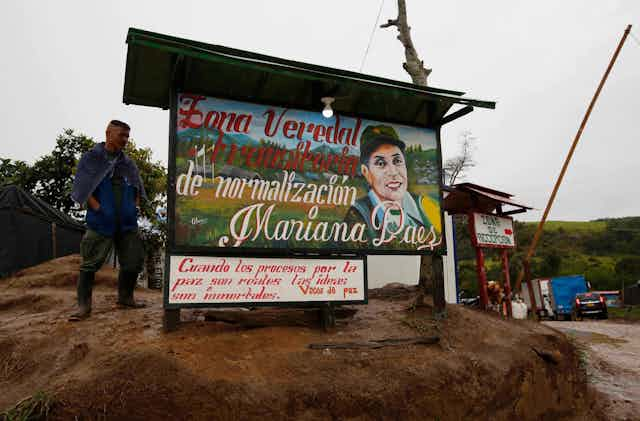Former members of the Farc guerrilla army in Colombia who laid down their arms as part of a peace deal in 2016 are being forced off the land they were allowed to settle after they demobilised.
More than 200 families of the Mariana Páez community, about eight hours south of the capital Bogotá in Colombia’s Meta department, have had to flee the hamlet they have lived in following demobilisation due to threats from dissident former Farc fighters who have refused to accept the treaty.
Another group of about 360 people have reportedly also been forced off their land at Vista Hermosa, in the same region of Colombia, after the assassinations of two former Farc guerrillas, both signatories to the peace deal, and subsequent death threats.
But the community of Mariana Páez is particularly symbolic. It was the site of the official ceremony in which the Farc members formally laid down their weapons in 2017. Mariana Páez and Georgina Ortiz (the name of the community in Vista Hermosa) are two of more than 20 reintegration and training spaces built with international support as part of the peace deal signed by the guerrilla group with the Colombian government the previous year.
Nowadays, many of these camps look like other Colombian villages. Only at a second glance one sees the various wall paintings of Che Guevara, former Farc leaders and revolutionary slogans.
“Mariana Páez is our home,” community spokesperson Jasbleidy Cabana told me. “We have built this place and many of us have started families here.” Yet, in March, the community was told to leave by members of a splinter group of former Farc fighters, the Estado Mayor Central (EMC), that refused to sign the peace agreement.
The Farc’s demobilisation
After the 2016 peace deal, some 13,000 Farc members demobilised. They handed over their weapons to the United Nations and joined a programme to assist in reintegrating them into civil society. Since then, almost 400 have been assassinated, and even more have been internally displaced.
The EMC has an estimated 3,500 members across 23 of Colombia’s 32 departments. While it seems paradoxical that a group of former Farc fighters would threaten their former comrades who have demobilised, Cabana explains: “The dissidents see us as traitors to Farc’s struggle. Moreover, many current members of the dissidents joined after 2016 and never got to know us.”
The Farc, from which the EMC emerged, started as a Marxist movement – but over the years, the EMC has become heavily involved in criminal activities, particularly narcotics trafficking. The EMC‘s ranks include former rebels, soldiers, paramilitaries and members of organised criminal groups.
Political responses
Colombian politics have done little to change the situation. In 2018, Iván Duque from the right-wing Democratic Center party – which fiercely opposed the 2016 peace deal – won the presidency. During his four-year term, his administration undermined several aspects of the agreement. Limited funding and political support meant that some of the peace deal’s key elements, such as land redistribution and an overhaul of rural Colombia, remained unfulfilled.
Then, in August 2022, Colombians elected the first left-wing government in the country’s recent history. The new president, Gustavo Petro, promised to implement the 2016 peace deal more thoroughly and seek additional peace settlements with any armed groups still active. “We have to comply with the peace agreement because that is how we can tell the other armed groups out there that the state is complying,” Petro announced in February .

One success of Petro’s so-called “total peace” initiative has been ongoing peace talks and a ceasefire since early August with the National Liberation Army (ELN), another leftist guerrilla group. Negotiations with this group in the past had been particularly complicated, given the group’s decentralised organisational structure, considerable autonomy of different regional units, and ideological inflexibility.
But this ceasefire is limited to exchanges between the ELN and the Colombian military. On August 20, violent clashes between the ELN and the EMC led to the displacement of 400 families in Samaniego, a municipality in the south-western Nariño department. In early September, the Red Cross reported clashes between these two groups, leading to the killings of ten people in the eastern Arauca department.
Similarly, the Colombian government’s negotiations with other groups are complex. In March, the government suspended a ceasefire with the Gulf Clan (formally the Gaitanist Self-Defence Forces of Colombia), a powerful criminal organisation which controls much of the drug trafficking across large parts of Colombia.
Symbolism for Colombia
So the evictions from the Mariana Paéz community are symbolic of the challenging task of achieving peace in Colombia, where lucrative illicit economies, such as the drugs trade and illegal gold mining continue to provide incentives for armed groups to operate.
In late May, the Colombian government suspended its ceasefire with the EMC in four Colombian departments, including Meta, after the group forcibly recruited four indigenous teenagers and shot them when they attempted to escape.
This led the people of Mariana Páez to leave the community, even though the EMC officially retracted its threats. “There are no guarantees for our lives, and also, the housing available is not dignified,” Cabana told me.
The families moved on August 10 to a nearby municipality, where the Colombian government has provided land that the community hopes will allow them to grow crops.
The community’s decision is thus emblematic of the security situation in rural Colombia. Announcements in early September by the government and the EMC that a new ceasefire and peace negotiations will soon begin provide hope. But the past has shown too often that violence and instability will persist. Providing security and enabling the reintegration of former Farc members into society will likely remain a major challenge.

